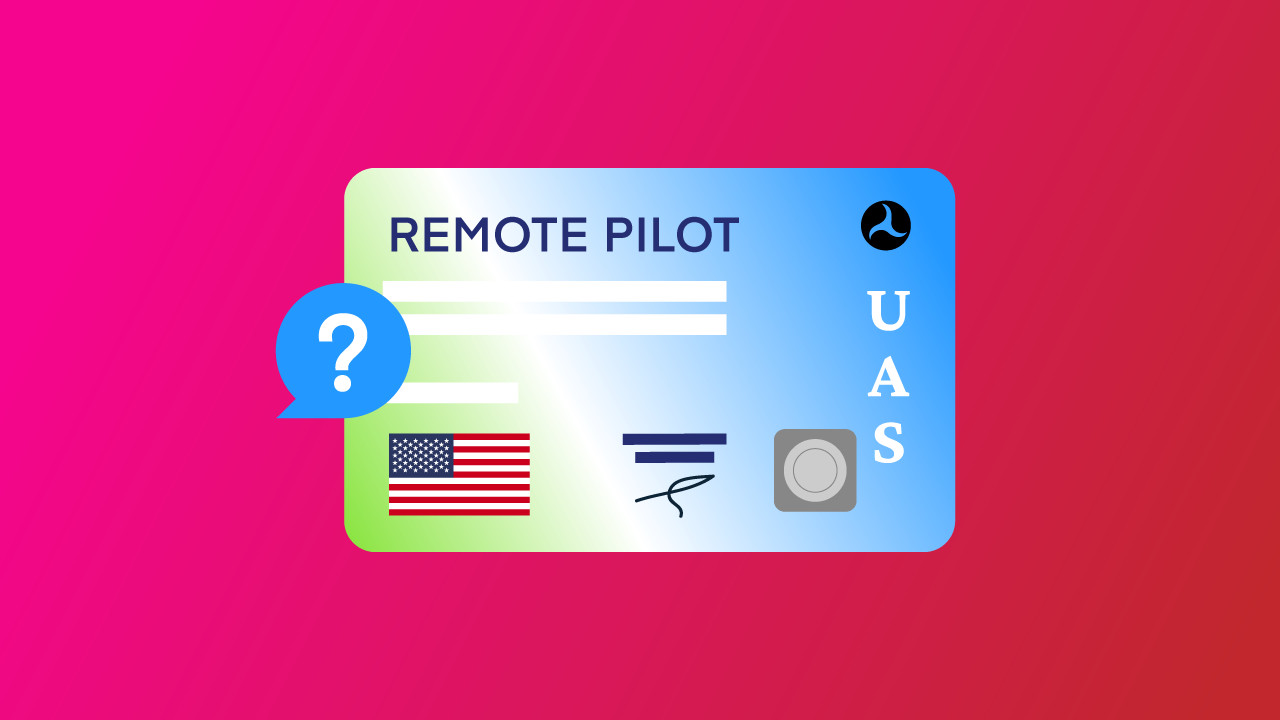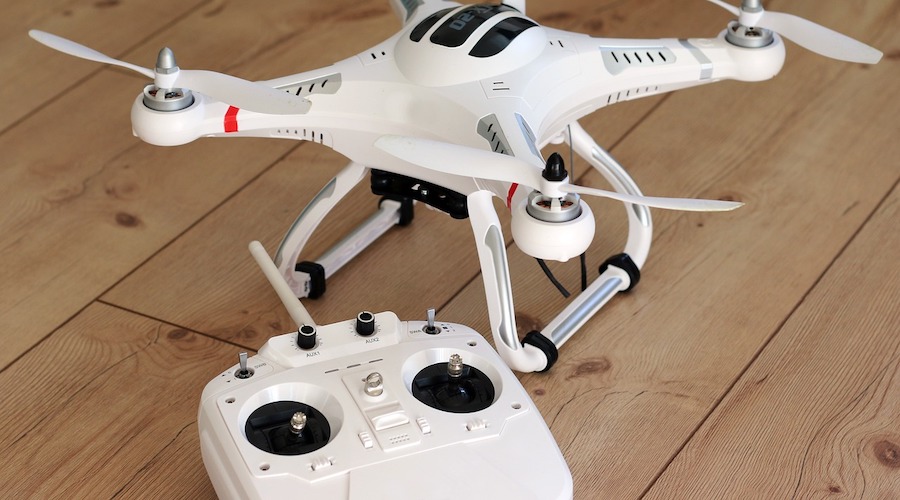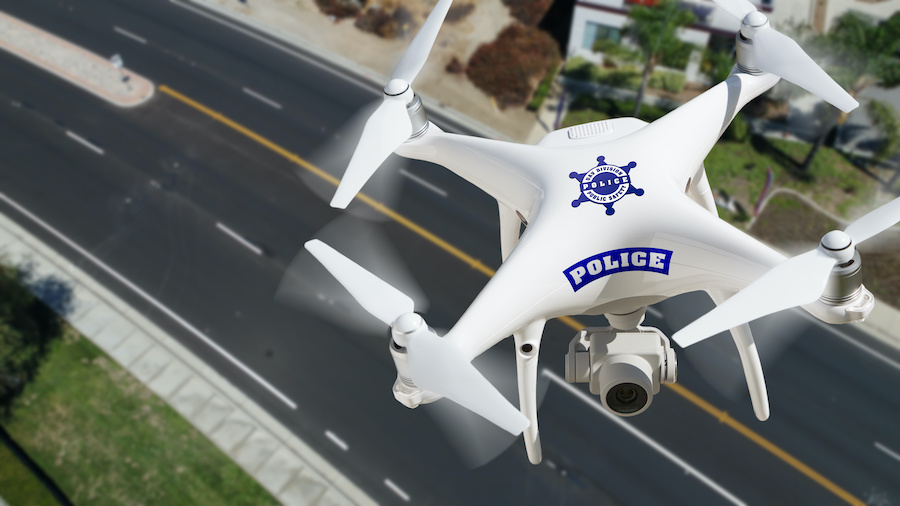-
Key Takeaways
-
Certificate vs. Currency—Know the Difference
- What “24-Month Recency of Aeronautical Knowledge” Means
-
How to Check Your Renewal Deadline
- 1. Read the Issue Date on Your Card/Test Report
- 2. Verify in FAASafety
- 3. Set Automated Reminders
-
Renewal Pathways Explained
- Path 1: ALC-677 Online Recurrent Course (Most Pilots)
- Path 2: ALC-451 for Current Part 61 Pilots
-
Step-by-Step: Completing ALC-677 in Under 2 Hours
- 1. Log In / Create FAASafety Account
- 2. Enroll in “Part 107 Small UAS Recurrent – Non-61 Pilots (ALC-677)”
- 3. Review Modules Efficiently
- 4. Pass the 45-Question Exam
- 5. Save & Distribute Completion Certificate
-
After You Renew: Recordkeeping and Compliance
- Carry Proof in the Field
- Update Operations Manuals & Insurance
- No New Plastic Card Myth
-
What If Your Currency Already Lapsed?
- Immediate Operational Impact
- Fast-Track to Reinstatement
- Recreational Flying During Gap
-
Common Misconceptions & FAQs
- “How long is Part 107 good?”
- “Is there a grace period?”
- “Do I need to re-register my drone when I renew?”
-
Pro Tips to Make Renewal Painless Next Time
- Leverage the FAA WINGS Program
- Keep Learning Beyond Minimums
-
Conclusion
Imagine you just landed that dream drone job you’ve been eyeing for months now. You finalize the contract, let’s say for a cool $4,000. Everything is going smoothly, until the client asks for your Part 107 Certification, you know, for insurance purposes.
The problem is you forgot to renew, and your license expired over a month ago. Now the client is canceling that sweet gig you thought you had in the bag.
With the license card only showing “Issue Date,” it’s easy to forget when your Part 107 validity expires. Unfortunately, too many drone pilots have mistaken certificate validity for currency validity.
In this article, we’ll clarify certificate versus currency validity, pinpoint your personal deadline, and walk through the fastest renewal path (ALC-677) with screenshots.
Key Takeaways
- Learn the difference between certificate validity and currency validity.
- Understand the FAA’s 24-month recency requirements to keep your Part 107 privilege status.
- Check for your renewal date.
- Find the right pathway, either ALC-677 or ALC-451, for Part 61 certificate holders.
- Follow our step-by-step renewal process to learn how you can renew in two hours or less!
- Explore your options for how to renew if you accidentally let it lapse.
Certificate vs. Currency—Know the Difference

Technically, your Part 107 certificate is permanent. It is valid unless surrendered or revoked by the FAA.
The license card you receive 120 days after acquiring Part 107 status does not technically expire. Thus, there’s no explicit expiration date on it.
What “24-Month Recency of Aeronautical Knowledge” Means
However, the FAA requires remote pilots to demonstrate “aeronautical knowledge recency” every 24 months.
While the certificate does not expire, according to FAR AIM Chapter 11, Section 5, the FAA only grants the “exercise of privileges of a sUAS certificate that was issued under 14 CFR Part 107” if pilots show currency, or that they stay up-to-date on their aeronautical knowledge.
That means that every two years, pilots have to satisfy certain recency requirements to retain the privilege to fly drones in a commercial capacity. Typically, this requires engaging in recurrent training to stay up-to-date with aeronautical knowledge.
Another point of confusion is that the FAA uses a calendar-month system to determine the expiration date for privilege status.
So as long as you stay current, expiration dates fall on the last day of the month that you initially received your Part 107 certificate. For example, if the certificate was issued on March 10, 2023, its currency validity would expire on March 31, 2025.
However, it is important to note that if, for whatever reason, you complete your recency knowledge training after the month of issuance, the situation changes. If you allow your recency to lapse but renew it at a later date, the 24 months start from the date you completed the training.
Let’s say my Part 107 was issued in June, but I forgot and did not complete the recency training until July 2025. The next due date would be set for July 31, 2027, instead of June 30th, 2027.
While this may seem like extra work, there is good intent behind the policy. Keeping current with aeronautical knowledge means being safe, point blank. It’s all too easy to forget key information, especially when you’re not flying day in and day out. Recurrent training is a vital refresh.
It is also critical for remote pilots to stay up-to-date with rule changes to ensure compliance. With many recent changes, such as expansion for night operations and flights over people, this means expanding your potential as a pilot.
How to Check Your Renewal Deadline
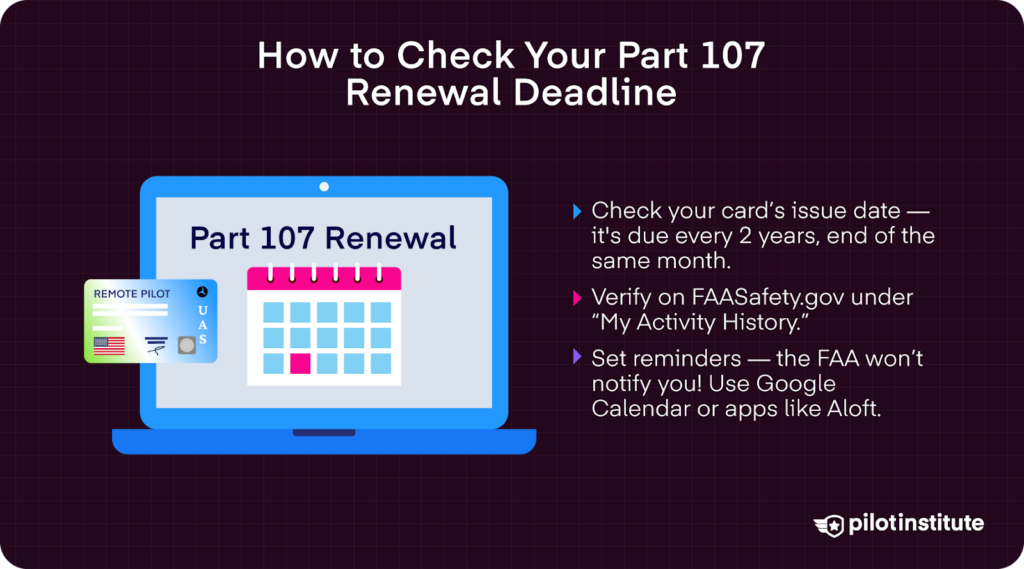
1. Read the Issue Date on Your Card/Test Report
It’s actually not that hard to figure out when you need to review. On the front left of your Part 107 certificate card, locate the “Date of Issue” section.
Apply the end-of-month rule to determine the exact date your privilege would expire. For example, mine was issued on June 11. That means I need to fulfill the FAA’s recency requirements by June 30th every two years.
Now, a word of warning: the FAA does not remind you! Unlike the FAA’s DroneZone website, which does send friendly reminders regarding drone registration, there is no scheduled reminder notification for recurrency requirements.
2. Verify in FAASafety
In the FAA Safety website, you can check the date of your completed course as well. In the menu on the right-hand side, under “Common Tasks,” click “View My Activity History.” There, you can see all the accredited activities, including the date completed.
Now, don’t freak out if you just realized that your last course was over the required 24 months. Keep reading to learn how you can easily reinstate your status, even after it expires.
3. Set Automated Reminders
After one too many times of forgetting myself, I got into the habit of setting automated reminders. Google Calendar allows for recurring events, where emails are sent 60, 30, and then 7 days before the expiration dates. Also, drone apps like Aloft can track currency dates.
Renewal Pathways Explained
Path 1: ALC-677 Online Recurrent Course (Most Pilots)
Remote pilots without a Part 61 certificate or a current flight review, i.e., most drone pilots, can take this recurrent course to update their status.
After reviewing several course modules on airspace, weather, Remote ID, and new rules (night operations/ operations over people), you will be prompted to take a 45-question exam that must be completed in 90 minutes.
Pilots must achieve a 100% score to pass. Pilots can take the exam multiple times to achieve the required score.
Upon passing the exam, your accredited activity will be immediately uploaded, and your recurrency requirements will have been met.
Path 2: ALC-451 for Current Part 61 Pilots
This option is for those pilots who also hold a Part 61 Certification and a valid flight review. Training typically takes around two hours, and the modules are similar to the ALC-677 course. The end-of-course exam must be completed in a single 90-minute session. Like the ALC-677, pilots must get a perfect 100% score to pass.
| Path | Cost | Location | Proof Generated | Best For |
| ALC-677 | Free | FAASafety.gov | PDF completion certificate | 98% of remote pilots |
| ALC-451 | Free | FAASafety.gov | PDF completion certificate | Current Part 61 pilots |
Step-by-Step: Completing ALC-677 in Under 2 Hours

1. Log In / Create FAASafety Account
The first step is to log in to the FAA Safety website. If you do not already have an account, make sure the name you add when creating one matches the name in the FAA’s Airman Registry exactly to avoid any syncing errors.
Note, the FAASafety website recently updated its password requirements to enhance encryption. Pilots with an existing account may need to update their passwords when logging on.
2. Enroll in “Part 107 Small UAS Recurrent – Non-61 Pilots (ALC-677)”
Once all set up, you can access the ALC-677 Recurrent course here. You can also type “677” in the main course catalog to find it in the larger course register. Click the status from “Preview” to “Enroll” and press the play button to begin.
3. Review Modules Efficiently
There are three main modules. The first is a simple introduction to the training framework and a revisit of some basic eligibility requirements for Part 107.
Module 2, Aircraft and Remote Pilot in Command Requirements, has two lessons. The first focuses on the characteristics of an sUAS, along with registration requirements.
The second features a review of the roles for the Remote Pilot in Command (PIC) and best practices for managing crews during sUAS operations.
The third module, Safe Operation of sUAS, has three lesson plans. The first covers preflighting, including environment and equipment assessment, and complying with Remote ID rules.
Then, the second lesson explores operating rules and limitations for sUAS operations. Finally, the third lesson explores common emergencies and how to handle them.
To save time, you can skim unchanged sections and focus more on the updated rules. This includes paying close attention to modules discussing night operations, operations over people, and the coming enforcement of Remote ID.
Personally, I took notes in a Word document the first time I took the test. It’s an open book, so having a text document you can search for words and phrases really helps during the exam. Then, when new things are added, I just update my notes and save them for the next time.
Pilots can also take advantage of the built-in mid-training knowledge checks that offer interactive questions to help study during the modules.
4. Pass the 45-Question Exam
The exam has a total of 45 questions answered in one 90-minute sitting. Questions are pretty easy if you have prepared! You can shave the test time down to 30 minutes or so.
Just remember, you must get a perfect score of 100% to pass! So, it may be worth a double check before submitting. However, you will have multiple attempts if needed.
5. Save & Distribute Completion Certificate
After completing the exam and submitting feedback, you will have the option to download your certificate and have the FAA email it to an employer or individual.
Download and save a PDF version of your completion certificate for your records. We recommend that you rename the file “ALC-677_MM-DD-YYYY,” filling in the date you completed the exam, and save it in the appropriate folder with your other important drone documents.
It would also be advantageous to upload a copy to a cloud server, like Google Drive or Dropbox, in order to have a copy on the go. Printing a copy and laminating it is also helpful when you’re in the field. Some insurance companies may also want their records updated, so check if that is necessary.
After You Renew: Recordkeeping and Compliance
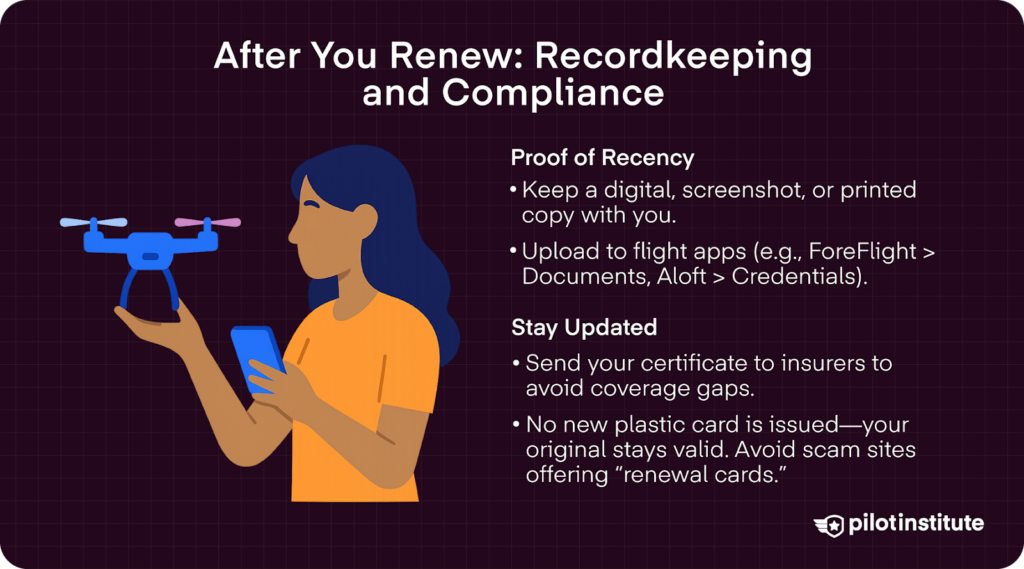
Carry Proof in the Field
Make sure you have proof of your recency completion when you are out in the field. Digital copies easily accessible from the cloud are sufficient. If you don’t think you will have internet access, a screenshot or a printed, laminated copy works great.
You can also update your credentials in flight apps. In Foreflight, you can add it to the “Documents” section of your profile, while on Aloft, it would go in the “Credentials” tab.
Update Operations Manuals & Insurance
Insurers may ask for a new currency date, so make sure to send a PDF copy immediately to avoid a lapse in coverage.
No New Plastic Card Myth
The FAA will not be sending another plastic Part 107 certificate. As we discussed earlier, the one you received when you were first issued your Part 107 Certification is permanent and does not need updating.
Don’t be fooled by websites offering easy “renewal cards” for a fee. The one you already have in your pocket is all you need.
What If Your Currency Already Lapsed?

Immediate Operational Impact
Right at 12:01 a.m., the day after the 24-month mark, you cannot legally fly for compensation. The show stops completely until you can renew by satisfying the recency requirements outlined by the FAA.
There are some pretty hefty penalties for ignoring the rules here. Fines can vary, but can rack up into the thousands of dollars. Civil penalties can even reach up to $27,500 per violation.
The FAA can also decide to revoke a pilot’s Part 107 status completely or even levy criminal sanctions that could result in imprisonment.
Fast-Track to Reinstatement
Forgot to renew in time? Well, don’t worry. Pilots can take the ALC-677 anytime, even if it has been years since the last lapsed renewal date.
Thankfully, that means you can still take the free currency test, rather than having to fork out another $150 and study for the significantly harder Part 107 exam all over again.
Recreational Flying During Gap
If your Part 107 currency requirement has lapsed, that doesn’t ground you entirely. As long as you follow the rules for recreational flying and do not fly for any form of compensation, you can still take flight.
A couple of things to note here. First, recreational pilots have to follow the guidelines set out in 49 U.S.C. § 44809, which dictates the laws for limited recreational operations of unmanned aircraft. That means adhering to FAA guidelines regarding flight operations and airspace restrictions.
Additionally, all recreational flyers must pass the TRUST test, a free competency test that is easy to obtain with us here at Pilot Institute.
However, you must not fly for compensation in any form. That means flying for cash or trade in any form.
Common Misconceptions & FAQs
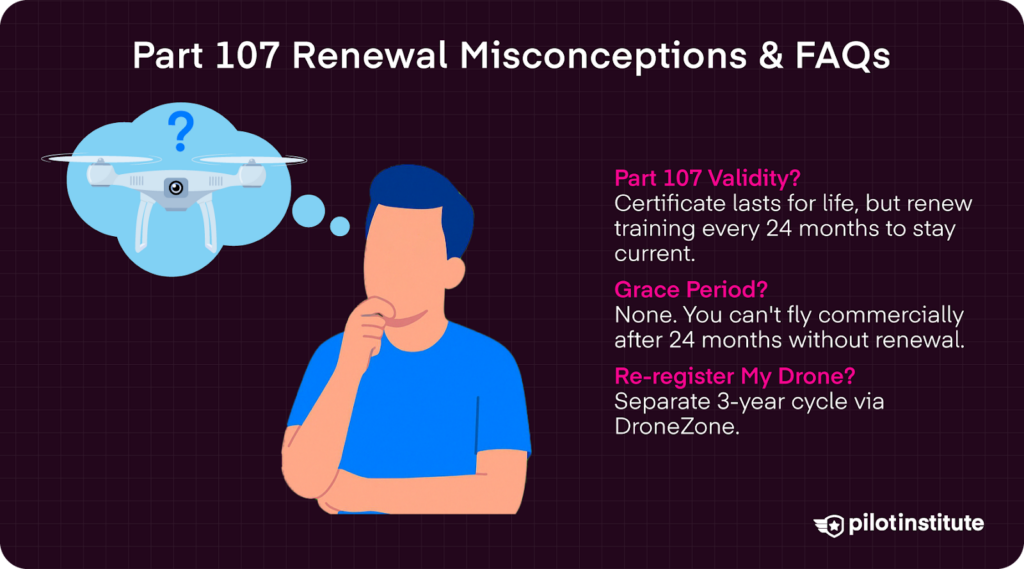
“How long is Part 107 good?”
Technically, a Part 107 Certification is “good” for a lifetime. The certification itself does not expire. However, every 24 calendar months, pilots must show adherence to aeronautical recency requirements, such as taking the ALC-677 refresher course.
“Is there a grace period?”
There is no grace period, zero. If you are not current on the first day of the 25th month, you are not in compliance with FAA regulations and must stop flying commercially in any context until recency requirements are met.
Fortunately, if you missed your renewal date, there are no penalties. You won’t have to start all over again in your certification journey; you just need to satisfy the recency requirements to reinstate your Part 107 privilege.
“Do I need to re-register my drone when I renew?”
No, DroneZone registration is a separate 3-year cycle. Luckily, DroneZone is much better about reminding pilots when their registration due date is on its way!
Pro Tips to Make Renewal Painless Next Time
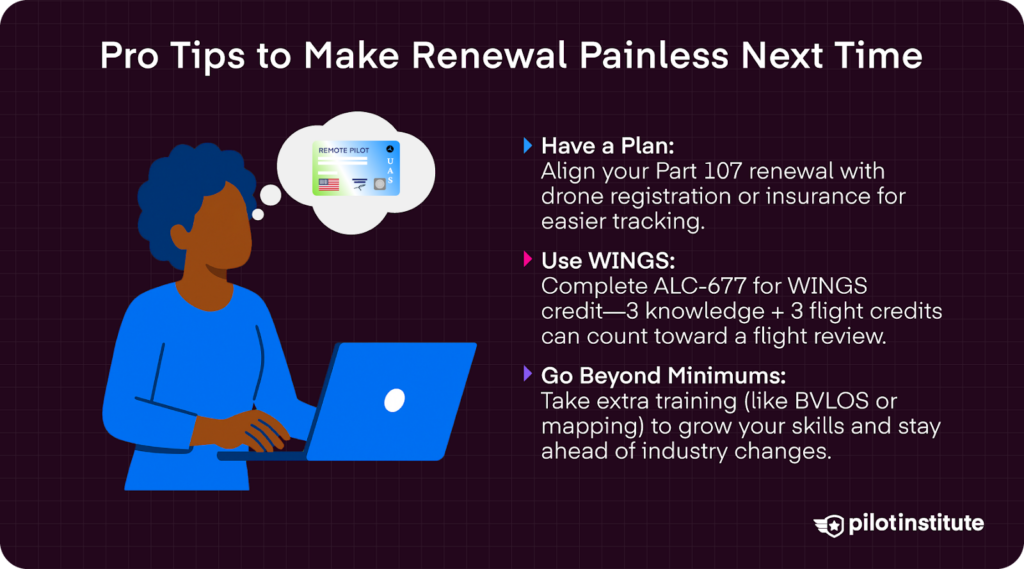
If you have the option, you can strategically plan your Part 107 recency requirement renewal with your drone registration due date or insurance renewal. This way, you are more aware of when everything needs to be done and do it all in one fell swoop.
Leverage the FAA WINGS Program
You can also team up the recency requirements with the WINGS Pilot Proficiency Program, which requires three knowledge activity credits and three flight activity credits within a year. Completing ALC-677 earns Basic WINGS credit, and these can accumulate for flight-review alternatives.
Keep Learning Beyond Minimums
Look beyond the basics and dedicate time to ongoing training to empower you as a pilot. Various additional courses can open up greater operational potential, such as BLVOS ground courses, like Pilot Institute’s Part 107 and Public Safety COA Course. You can also dedicate time to training for specific uses like mapping and photogrammetry. Staying up-to-date with cutting-edge innovations in the industry and major regulatory changes makes you more competitive.
Conclusion
So to recap, the Part 107 Certification lasts for life, but its currency doesn’t. Make sure you renew every 24 months to stay compliant, or risk losing earning power.
It’s not nearly as difficult or time-consuming as the initial Part 107 exam. Block out at least two hours and take the free ALC-677 test on the FAA Safety website. Upon completion, you will immediately receive your certificate and be back in the air.
Staying current isn’t a burden caused by red tape. It’s proof of professionalism. Make sure to stay current and renew every 24 months!
